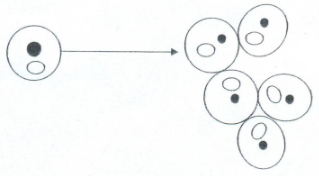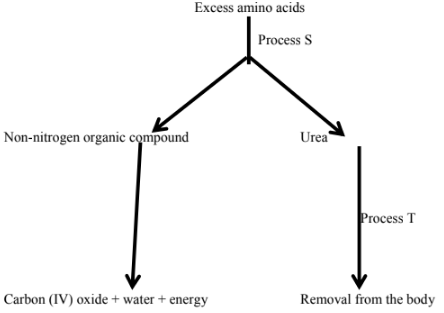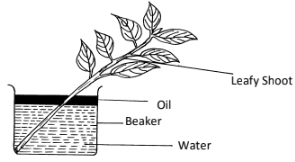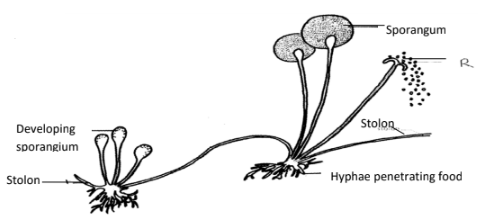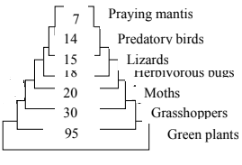INSTRUCTIONS TO CANDIDATES
- The paper consists of Sections A and B.
- Answer ALL questions in Section A in the space provided
- In Section B answer question 6 (compulsory) and either 7 or 8 in the space provided.
SECTION A
- The diagram below represents a process in a given organism.
-
- Name the organism (1mk)
- Identify the process that is shown to be taking place. (1mk)
- State the economic importance of organisms found in the kingdom which the organisms shown above belong (2mks)
-
- Define the term species (2mks)
- State two principles of binomial nomenclature (2mks)
-
- The information given below was obtained in a certain ecosystem
Organism Biomass
Green plants 95
Lizards 15
Praying Mantis 7
Predatory birds 14
Moths 20
Grass hoppers 30
Herbivorous bugs 18- Construct a labeled pyramid of biomass (2mks)
-
- Construct four step food chains (2mks)
- State two ways in which energy is lost in an ecosystem (2mks)
- From the data given above state two groups of animals competing for the same resource (2mks)
- Proteins are present in a balanced diet. They are broken down into amino acid, the body cannot store amino acids, and so any excess amino acids are metabolized as shown below.
- Names the process S and T, stating the organ in which each occurs. (4 mks)
Process Name Organ S T - Describe how urea is transported to the site of removal from the body. (2 mks)
- State the type of respiration shown, giving a reason to explain your answer (2 mks)
- Names the process S and T, stating the organ in which each occurs. (4 mks)
- An experiment shown below was set-up to investigate a certain physiological process in plants:
- What process was being investigated (1 mk)
- Give the role of the oil layer in this experiment (1 mk)
-
- What observation did the students make after leaving the set-up in bright sunlight for two hours (1 mk)
- Explain the observation in (c)(i)above (1 mk)
- What effect will the following have on the observation made:-
- Fanning the shoot (1 mk)
- Removing all the leaves from the shoot (1 mk)
- Placing the set-up in the dark (1 mk)
- Suggest a suitable control for this experiment (1 mk)
- The diagram below represents a bread mould.
-
- Name the Kingdom to which bread mould belongs. (1 mk)
- Give three distinguishing characteristics of the Kingdom named in (a)(i) above. (3 mks)
- Give four general characteristics of Class Mammalia (4 mks)
-
SECTION B
- Two persons X and Y drunk volume of concentrated solutions of glucose. The amount of glucose in their blood was determined at intervals. The results are as shown in the table below.
Time (Min) Glucose level in blood (mg/100cm3) X Y 0 87 84 15 112 123 30 139 170 45 116 188 60 100 208 90 95 202 120 92 144 150 88 123 - On the grid provided, plot graphs of glucose level in the blood of X and Y against time, on the same axis. (8mks)
- What was the concentration of glucose in blood of X and Y at 20th minute (2 mks)
X
Y - Suggest why the glucose level in person X stopped rising after 30 minutes while that of person Y kept on rising (2mks)
- Account on decrease in glucose level in person X after 30 minutes and Y after 60 minutes. (4mks)
- Name the compound that stores energy released during oxidation of glucose in cells (1mk)
- Explain what happens to excess amino acids in man (2mks
- State the assimilation of fatty acids and glycerol in man (1mk)
- Discuss the methods of seed and fruit dispersal and their characteristics. (20mks)
- Describe the process of digestion that takes place when one eats an egg and ugali.
(20 mks)

MARKING SCHEME
-
-
- Yeast (1x1 = 1mk)
- Budding (1x1 = 1mk)
-
- Causes plant and animal diseases e.g. athletes foot
- Causes food spoilage
- Source of food e.g. mushroom
- Used for manufacture of antibodies (1x2 = 2mks)
-
- A group of organisms that can freely, naturally interbreed and produce a fertile/viableoffspring (1x2 = 2mks)
-
- First name (generic) should start with a capital letter. The specific name is written in small letters
- If hand written the names should be underlined separately
- If typed they should be printed in italics (1x2 = 2mks)
-
-
Correct drawing - 1mk
Labeling -1mk
(1x2 = 2mks)-
- Green plants → Herbivorous Bugs → Predatory Birds → Lizards
Green plants → Grasshoppers → Predatory Birds → Lizards
(1x2 = 2mks) -
- Not all green plants materials are digested
- Heat lost in feaces
- Indigestible materials
- Transpiration/sweating (1x2 = 2mks)
-
- Herbivorous bugs and grasshoppers both feed on / compete for greenplants
- Praying mantis and predatory birds compete for herbivorous bugs (1x2 = 2mks)
- Green plants → Herbivorous Bugs → Predatory Birds → Lizards
-
- S- Deamination; Liver;
T – Excretion; Kidney; (2 x2 = 4mks) - Liver → Hepatic veins → vena cava; →Heart→Lungs → Heart → Aorta→ Renal artery
Correct identity 1mk
Sequence 1 mk
(2x1 = 2mks) - Aerobic respiration; since water is released; (1x2 = 2mks)
- S- Deamination; Liver;
-
- Transpiration (1x1 = 1mk)
- Prevent evaporation of water from the surface (1x1 = 1mk)
-
- The level of water drops (1x1 = 1mk)
- Due to loss of water to the atmosphere by transpiration (1x1 = 1mk)
-
- Faster drop in water level (1x1 = 1mk)
- No change in water level; (1x1 = 1mk)
- Slower/very slow drop in water level; (1x1 = 1mk)
- Another set up using a leafless twig; (1x1 = 1mk)
-
-
- Fungi/mycophyta: (1x1 = 1mk)
-
- Non— green/ lacks chlorophyll;
- Body made up of hyphae/ mycelia;
- (Asexual) reproduction: OWTTE (1x3 = 3mks)
-
- Body is covered by fur or hair;
- Have mammary glands (for milk production);
- Have external earlobes;
- Have highly developed brain;
- Have muscular diaphragm that have sweat glands;
- Have muscular diaphragm (that thoracic cavity from abdominal cavity);
Mark first three
(1x4 =4mks)
-
-
-
- For exchanged axis award
- Scale must be correct
- For graphs on separate axis, mark both and award the highest
A = 2
S = 1
P = 1
l = 2
C = 2
- X = 120 ± 3
Y = 140 ± 3 (1x2 = 2mks) - Person X is able to regulate glucose, while Y is likely to be diabetic (1x2 = 2mks
- X – Insulin; is released excess glucose is converted to glycogen
Y – Insulin is not released; the decrease is due to glucose being lost in urine
(1x4 = 4mks) - A.T.P / Adenozine triphosphate (1x1 = 1mk)
- Deaminated; the ammonia combines with CO2 to form urea (and H2O); (carbohydrate group is oxidized / stored as glycogen) (1x2 = 2mks)
- Oxidized to produce energy / converted to neutral fats and stored around some organs (1x1 = 1mk)
-
-
- Water dispersed fruit/seeds
Mesocarp/ seed have air spaces thus light/ buoyant to float; therefore carried away by water;
The fruits/seeds are protected from soaking by waterproof pericarp - Animal dispersed fruits/seeds
Presence of hooks; for attachment to animals; thus carried to other places; fruits are brightly coloured; succulent; aromatic to attract animals; which feed on them.
The seed coats are resistant to digestive enzymes; thus taken to other places with the animal droppings; (away from parent plant) - Self dispersed fruits/seeds/explosive mechanism;
The dry pods /fruits split (along lines of weakness/ saturates); scattering seeds away from mother plant - Wind dispersed fruits/seeds
They are light; to be carried away by wind\
Presence of hairs /wing-like structures; to increase surface area for buoyancy to enhance the fruits/seeds to be blown away by wind;
Censer mechanisms; perforated capsule is usually loosely attached; to the stalk/ the long stalk is swayed by wind scattering seeds
(2 x 10 = 20mks)
- Water dispersed fruit/seeds
-
- Mouth
- Chewed using teeth;to increase surface area for enzyme action;
- Ptyalin/salivary amylase digest starch; into maltose;
- Saliva has water; to moisten/soften food;
- Saliva has mucus; for lubrication;
- Saliva has slightly alkaline – suitable pH for ptyalin/amylase;
- Stomach
- pepsin digests protein; into peptides;
- No starch digestion due to unsuitable pH/ presence of HCl/Acidic media;
- HCL activate pepsinogen into pepsin;
- HCL provide suitable pH for action of pepsin;
- Duodenum
- Trypsin digests proteins; into peptides;
- Pancreatic amylase digest starch into maltose;
- Sodium bicarbonate : provides suitable pH/neutralize acidic chyle;
- Bile juice: provided suitable pH /neutralise acidic chyle;
- Ileum
- Peptidase digests peptides into amino acids;
- Maltase digest maltose into glucose;
(20 mks)
- Mouth
Join our whatsapp group for latest updates
Tap Here to Download for 50/-
Get on WhatsApp for 50/-
Download Biology Paper 2 Questions and Answers - Form 3 Mid Term 2 Exams 2021.
Tap Here to Download for 50/-
Get on WhatsApp for 50/-
Why download?
- ✔ To read offline at any time.
- ✔ To Print at your convenience
- ✔ Share Easily with Friends / Students

